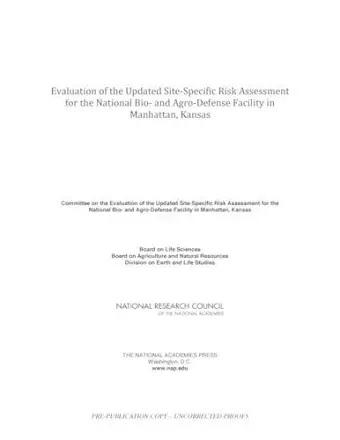Evaluation of the Updated Site-Specific Risk Assessment for the National Bio- and Agro-Defense Facility in Manhattan, Kansas
National Research Council author Division on Earth and Life Studies author Board on Life Sciences author Board on Agriculture and Natural Resources author Committee on the Evaluation of the Updated Site-Specific Risk Assessment for the National Bio- and Agro-Defense Facility in Manhattan, Kansas author
Format:Paperback
Publisher:National Academies Press
Published:24th Sep '12
Currently unavailable, and unfortunately no date known when it will be back

Safeguarding U.S. agriculture from foreign animal diseases and protecting our food system require cutting-edge research and diagnostic capabilities. The Department of Homeland Security (DHS) and the U.S. Department of Agriculture (USDA) have embarked on an important mission to replace the aging Plum Island Animal Disease Center (PIADC) with a new facility, the National Bio- and Agro-Defense Facility (NBAF). When operational, this new facility would be the world's fourth biosafety level-4 laboratory capable of large animal research. It would serve as a critical world reference laboratory for identifying emerging and unknown disease threats, and would thus be a critical asset in securing the future health, wealth, and security of the nation.
DHS selected Manhattan, Kansas, as the site for the new NBAF after an extensive site-selection process that involved an environmental impact statement. The Government Accountability Office (GAO) raised concerns about DHS's analysis of the potential spread of foot-and-mouth disease virus (FMDv), one of the most serious foreign animal disease threats. Congress directed DHS to conduct a site-specific risk assessment (SSRA) for the NBAF, instructed the National Research Council (NRC) to independently evaluate the SSRA, and prohibited obligation of NBAF construction funds until the NRC review was complete.
Congress mandated that DHS revise its SSRA to address shortcomings of the 2010 SSRA, directed the NRC to evaluate the updated SSRA (uSSRA), and again prohibited obligation of construction funds until the completion of the second review. The scope for both of these SSRA reports addressed accidental release of pathogens from the NBAF in Manhattan, Kansas and excluded terrorist acts and malicious threats from its risk assessments. Evaluation of the Updated Site-Specific Risk Assessment for the National Bio- and Agro-Defense Facility in Manhattan, Kansas is the evaluation of the final uSSRA.
Table of Contents- Front Matter
- Summary
- 1 Introduction
- 2 Evaluation of Design, Operations, and Response Planning as Related to the Risk Assessment
- 3 Evaluation of Risk Approach and Calculations
- 4 Evaluation of Accident Event Modeling
- 5 Evaluation of Fate and Transport Modeling
- 6 Evaluation of Epidemic Modeling
- 7 Evaluation of Economic Modeling
- 8 Evaluation of Biosafety Level 4 Assessment
- 9 Overall Assessment, Findings, and Conclusions
- Appendixes
- Appendix A: Committee Biosketches
- Appendix B: Meeting Agendas and Lists of Public Participants <
ISBN: 9780309257824
Dimensions: unknown
Weight: unknown
132 pages